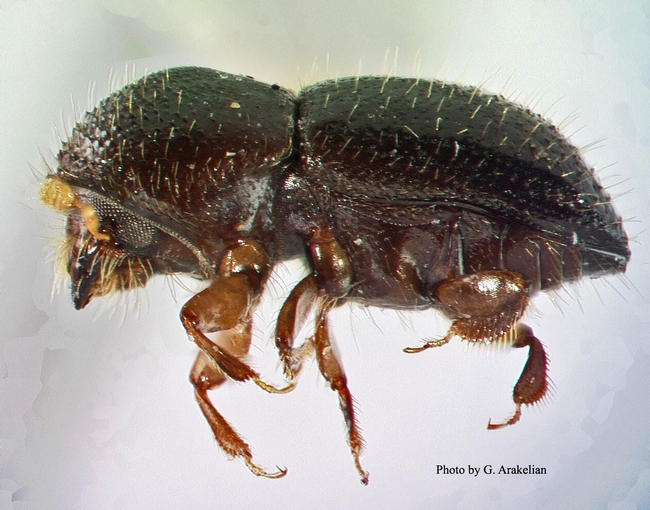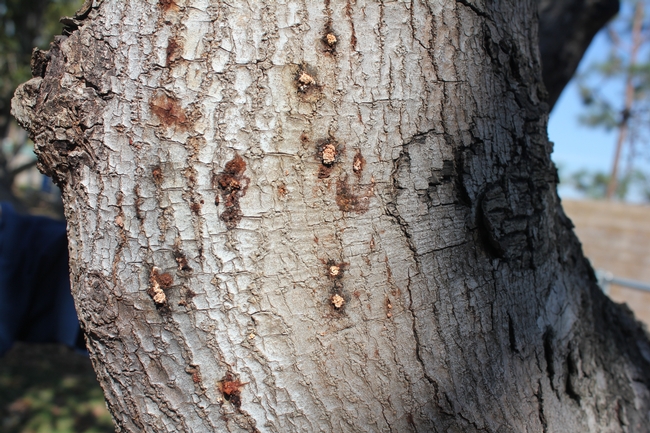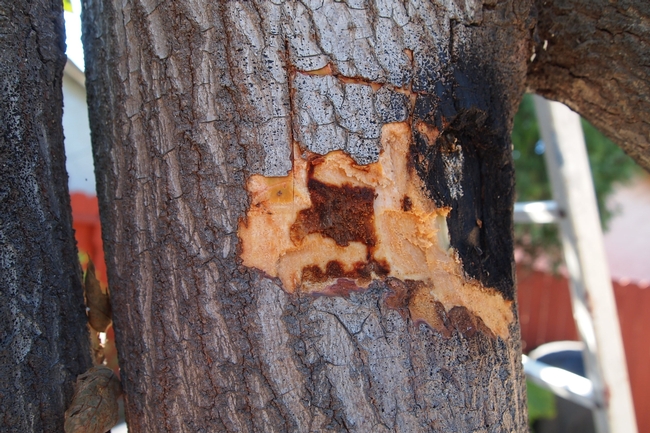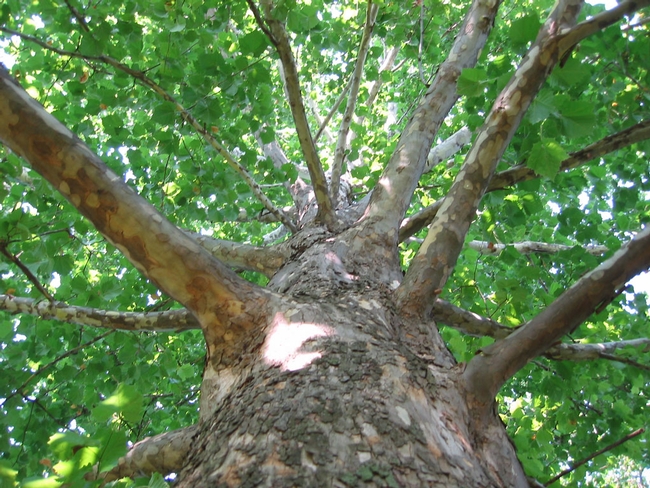
Posts Tagged: shot hole borer
Watch Out For Invasive Shot Hole Borers on Your Landscape Trees
Watch out for these insects! Invasive shot hole borers (ISHB) represent two related species of beetles (polyphagous and Kuroshio) in the genus Euwallacea. Both spread fusarium dieback, a disease that restricts the flow of water and nutrients in the tree, resulting in dead branches, dropped limbs, and even death. Over 60 species of native and non-native ornamental trees and avocados in Southern California are susceptible the ISHB/fusarium dieback complex.Examples of known hosts of the ISHB/fusarium dieback complex include: Box Elder (Acer negundo), Avocado (Persea americana), English Oak (Quercus robur), Valley Oak (Quercus lobata), California coast live oak (Quercus agrifolia), Big leaf maple (Acer macrophyhllum) silk tree (Albizia julibrissin) Liquidambar (Liquidambar styraciflua), Coral tree (Erythrina coralladendron), California sycamore (Platanus racemose), Blue Palo Verde (Cercidium floridum), Purple orchid tree (Bauhinia variegate), Kurrajong (Brachychiton populneus); and many species of Acacia.
The beetles are native to Southeast Asia and were likely introduced into California in shipped goods, wood products, or packaging. While tiny (about the size of a sesame seed), they are prolific, tunneling into host trees and living and reproducing in galleries while feasting on the disease-causing fungus they spread from tree to tree. Females are black and much more common than the small wingless brown males, which are rarely found.

While the initial infestation occurred in Los Angeles County in 2003, beetles travel about 12 miles a year and have now spread fusarium dieback into Orange, San Diego, Riverside, San Bernardino, Ventura, and Santa Barbara Counties. Orange County alone has spent millions of dollars removing infested trees and managing the spread of the ISHB/fusarium dieback complex.
Identifying ISHB in a timely way is essential to reduce damage and slow its spread. Look for round borer entry holes about the size of the tip of a medium ballpoint pen. Staining, gumming, discoloration of wood beneath the bark, and/or frass (sawdust-like material) are other common signs and symptoms. There may also be white powdery exudate around beetle entry holes. Keep in mind that there are many other disorders that have similar symptoms. For example, other fungal diseases produce exudate and staining and other types of borers leave entry holes of various shapes and sizes.


To date, no effective control measures have been found once trees are infested, although entomologists and plant pathologists from the University of California, The USDA Forest Service and other agencies continue to research viable integrated pest management options including biological control.
To prevent and/or reduce spread of ISHB/fusarium dieback:
- Bring only ISHB-free greenwaste (used for mulch and soil amendments) and firewood onsite. Both products can harbor ISHB which can persist for months.
- Treat infected wood onsite whenever possible. Wrap or completely cover wood that cannot be immediately treated and wood that is moved offsite for treatment elsewhere.
- Chipping infested wood to 1 inch or less can kill 95% of the beetles, while solarizing it using a clear tarp eliminates both ISHB and spores produced by the fungus. Logs can also be solarized. Composting is another option that, when done correctly, can kill both beetles and fungal spores.
- Untreated logs, branches, or woodchips infested with ISHB should not be used for firewood or mulch.
- Remove stumps as well as dead trees.
- Follow International Society of Arboriculture pruning standards and never top or flush cut trees which leave open wounds.
- Spray a 70% ethanol solution on equipment and tools since fusarium fungi can adhere to both.
- Keep trees healthy (water mature trees deeply and infrequently, avoid over or under-fertilization, etc.).
- Monitor susceptible tree species often to identify damage as early as possible. Useful detection and reporting tools and more detailed information on the ISHB/fusarium dieback complex can be found here: ucanr.edu/sites/pshb
For more detailed information on the ISHB/fusarium dieback complex, please visit these websites: https://ucanr.edu/sites/pshb/ https://www2.ipm.ucanr.edu/agriculture/avocado/polyphagous-shot-hole-borer-and-kuroshio-shot-hole-borer/ https://cisr.ucr.edu/invasive-species/polyphagous-shot-hole-borer https://californiareleaf.org/pests/
Invasive Spotlight: Wrapping Up California Invasive Species Action Week
This week, we put the spotlight on invasive species and how these non-native plants, animals, and...
Loss of trees could portend loss of human life
An invasive pest from Asia is killing thousands of trees in Southern California, which may lead to the death of thousands of humans, reported Adam Rogers on Wired.com.
Polyphagous shot hole borer females drill holes inside trees to lay their eggs. In the process, they deposit a fungus that grows and provides food for larvae. The fungus gums up the trees' channels for water and nutrient transport, eventually killing it. Called Fusarium dieback, the condition is on track to kill 26.8 million trees across Southern California in the next few years.
With data from a U.S. Forest Services study, which found that fewer trees is related to respiratory and cardiovascular disease deaths in people, the reporter underscored the dire human-health implications of polyphagous shot hole borer.
Trees also provide valuable "ecosystem services," such as reducing light and heat intensity, protecting water, cleaning the air of pollutants, providing wildlife habitat and storing carbon. The forest service combined satellite data and field plot data to calculate the costs and benefits of trees. The potential loss of ecosystem services because of polyphagous shot hole borer is $1.4 billion, not including the public health cost.
“A normal response to an invasive pest means millions of dollars would be thrown at it,” said John Kabashima, UC Cooperative Extension advisor emeritus who is working on staving off a catastrophe. “This one has received hundreds of thousands.”
Kabashima and other scientists are identifying infected trees to cut them down and chip the wood to prevent further spread. The tell-tale signs are little holes and sugar volcanoes that tend to show up first on the north side of the trunk or limb.
"You have to get out and walk around each tree, which we're doing in Orange County parks," Kabashima said. "We go out on off-road Segways. We can cover square miles in a day."
UC Cooperative Extension uses UC Irvine campus as a living lab

"The beauty of UCI is that it's a university, and they're used to researchers," said John Kabashima, an environmental horticulture advisor and entomologist with the UC Cooperative Extension in Orange County.
Another scientist on the project is Akif Eskalen, UC Cooperative Extension plant pathology specialist based at UC Riverside. Eskalen first identified the sesame seed-sized beetle in a South Gate avocado tree in 2012.
Eskalen selected 130 sycamores at UCI for his experiment and divided them into 13 groups of 10. Four of the groups were treated with different insecticides; three were treated with different fungicides; and four others got one of each. Another group was given a beneficial bacteria found in some California trees that's thought to kill the fungus. A final group is serving as a control and received no treatment at all.
The scientists are allowed to cut down and section the trees, sample them, and even leave some infested trees alone. Having this flexibility is essential to understanding the success — or failure — of a given pesticide, Kabashima said: "That's why we're learning so much here at UCI."
UC Irvine gets landscape tree help from UC ANR

Polyphagous shot hole borer has been present on the campus for two to three years. The extent of the infestation became apparent in the last few months when a significant number of trees began showing severe symptoms. UCI groundskeepers began to more closely examine a number of trees that appeared to be particularly distressed and worked with UC ANR staff to identify PSHB in early 2015.
A team of UCI staff qualified in tree management is receiving training from UC ANR (UC Riverside and UCCE) to properly identify and assess PSHB infestation. The team will monitor all trees on the UCI campus and, with input from faculty and students from UCI's Center for Environmental Biology, make the determination about which infected trees will be removed.
The news release suggests area property owners who suspect their own trees are infested with PSHB contact John Kabashima, UC ANR environmental horticulture advisor at the UC South Coast Research and Extension Center, 7601 Irvine Blvd., Irvine, CA 92618, pshb.ucce.oc@gmail.com.

